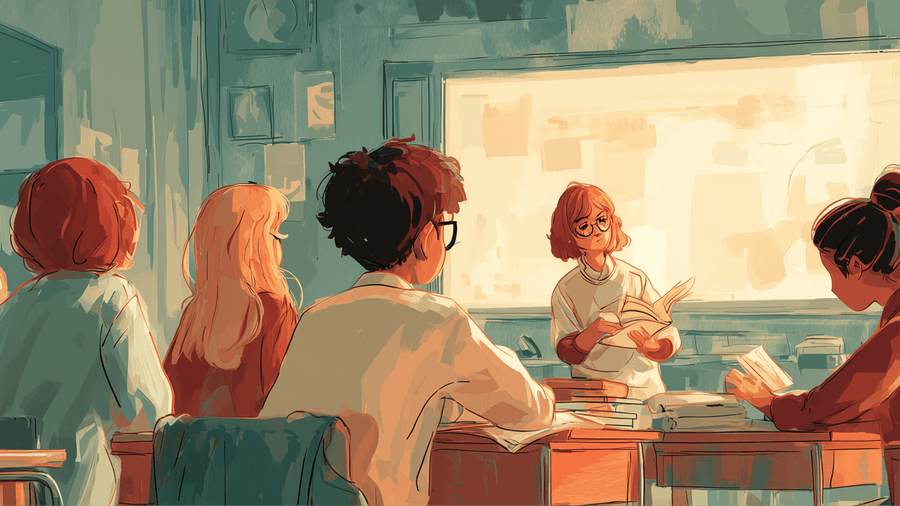The use of artificial intelligence (AI) is the new black in education. This technology has the potential to fundamentally change the way people teach and learn and optimize the learning process.
Today, for students, AI and schoolwork go together like cookies and milk — with 84% of high schoolers now using GenAI tools like ChatGPT for their assignments, up from 79% just a few months ago.
Teachers aren’t far behind, they’re embracing AI as a classroom ally, experimenting responsibly while staying at the heart of learning. UNESCO’s latest session highlighted that empowering teachers to shape AI, not be shaped by it, is key to the future of education.
The ever-increasing user interest correlates with dynamic market growth; it is estimated that by 2030, the total value will exceed USD 55,444 million.
Let’s take an in-depth look at how AI benefits education, what AI capabilities make up these numbers, and what opportunities and risks arise from the new technologies in education.
First, what’s AI in education?
AI in education involves machines that learn and make decisions based on data, enhancing personalized learning and administrative efficiency.
What is its logic? It goes beyond normal processing by connecting data points to make general assumptions, not just repeating learned information. Instead, it represents the actual thinking power that enables machine learning and, more advancedly, deep learning through artificial neural networks.
If you’re quite new to AI in education, check out three major application areas where AI can automate tasks and learn why they’re widely used. Or skip to the next section.
For teachers:
- Automatically grade assignments and exams, providing instant feedback to students;
- Generate and customize lesson plans based on curriculum standards and student needs;
- Track and analyze student performance to identify areas needing additional support.
For students:
- Create customized learning experiences based on individual strengths and weaknesses;
- Provide AI-driven tutoring and homework help, offering explanations and practice problems;
- Suggest study schedules and remind students of deadlines and upcoming assignments.
For businesses:
- Suggest personalized courses to learners based on their preferences and learning history;
- Analyze user behavior to target marketing campaigns more effectively;
- Streamline the enrollment process by automating application sorting and responses.
Understanding how to use AI in the education sector can help improve student engagement and make teaching more efficient. See how AI can make teaching and learning smarter.
As AI becomes woven into everyday learning, teachers and students are both finding new ways to adjust.
The APA 2025 Trends Report shows that around 7 in 10 teens now use generative AI tools, mostly to get help with homework, and many already show a thoughtful awareness of both the benefits and the risks.
Educators, in particular, are finding support in AI tools by automating grading, inspiring lesson plans, and assisting diverse learners, while they work to keep empathy and human connection at the heart of the classroom. Psychologists say this shift is more than technical; it’s emotional too.
What are the AI must-haves for an eLearning platform?
Explore six neuroscience-backed AI tools that elevate eLearning experience from content delivery to impactful learning.
How AI helps in education: practical applications
AI technologies relevant to schools can be grouped into seven categories. Some systems teachers can easily use on their own for lesson planning, while others need to be integrated into the school’s system first. In this dedicated piece, we’ve taken a closer look at key statistics on AI in education – check it out to stay up to date.

Both technology groups can significantly benefit your work, supporting both teaching and learning. For example, generative AI can simultaneously relieve the burden on teachers and increase accessibility for students by incorporating innovative didactic approaches and formats.
As of the latest Microsoft overview, students use AI for the following purposes:
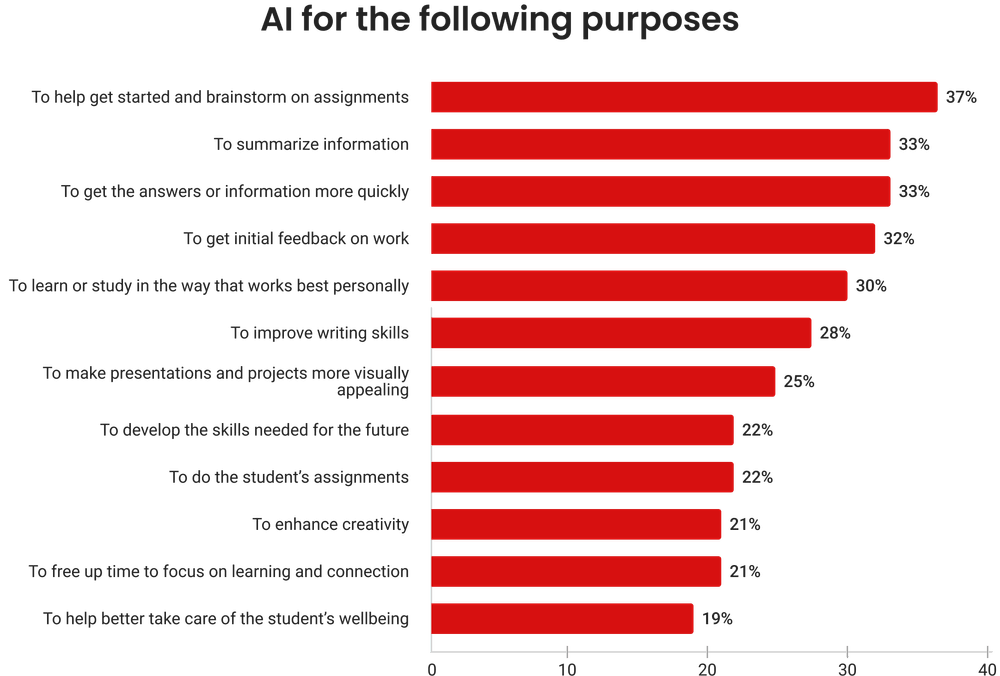
AI gamification tools
Teachers have long valued play-based learning, and educational computer games have been used in schools since The Oregon Trail was released in 1974.
Today, AI-powered educational games enhance this by creating personalized learning experiences via multiple techniques and applications.

AI-powered certification preparation
Preparing for professional certifications can be a daunting process for learners. They often need help identifying which topics to focus on, tracking their progress, managing study time, and staying motivated throughout the journey. AI-powered certification tools bring personalized guidance directly into the learning platform.
By analyzing learners’ strengths, weaknesses, and engagement patterns, AI can:
- create tailored study plans – for example, adjusting weekly targets based on topics a learner struggles with.
- Recommend targeted practice exercises – such as quizzes or mock exams focusing on weaker areas.
- Predict readiness for exams – for instance, estimating the likelihood of passing a certification before the test.
- Provide timely nudges and reminders – like alerting learners to review key topics before deadlines.
This approach boosts learner confidence, improves knowledge retention, and helps organizations achieve higher pass rates and more efficient learning outcomes.
Personalized AI for college admissions
Artificial intelligence is increasingly influencing the college admissions landscape. According to a survey cited by Inside Higher Ed, 50% of colleges were already using AI to review applications – a number likely higher today.
Tools can analyze essays for grammar, structure, and vocabulary, and some schools, like UNC, even use AI to pre-score writing before admissions officers read it.
At Purdue University, AI chatbots are taking the lead in handling student questions by managing 82% of initial inquiries, with most of them (71%) happening after hours. Interestingly, over a third of the students who chatted with the bot (about 35.5%) went on to submit an application.
Yet, while AI can streamline research and organization by helping students gather data on colleges, track activities, or manage projects, it cannot replace authentic critical thinking or original storytelling. Essays generated or heavily edited by AI risk appear formulaic, blending into a sea of similar submissions. Admissions officers are adept at spotting both unoriginal AI writing and genuine creativity.
Tips for students using AI ethically and effectively:
- Use AI for research, data organization, or project management, not essay writing.
- Treat AI suggestions for activities or projects as a starting point, not the final plan.
- Focus on originality: experiment with form, voice, and critical thinking.
- Start developing your unique perspective early in high school to stand out.
As for teachers, it may look like rerunning the same admission seminar every year, but teachers face different student paces, varied knowledge gaps, and diverse college‑path ambitions. When each student demands tailored support, the burden grows – and that’s before handling the paperwork, progress tracking, and follow‑ups.
That’s where AI tools come into play:
- Teachers often must build individual review plans for dozens of students every season. AI lets them generate tailored learning pathways instead of starting from scratch.
- Monitoring compliance with deadlines, applications, essays, and test prep consumes hours. AI alerts and dashboards can surface who’s falling behind in real‑time.
- Sifting through data on scores, activities, and readiness across cohorts takes manual effort. AI analytics can highlight trends and flag at‑risk students automatically.
- Responding to repeated questions from students about processes, requirements and options drains advisor time. AI chatbots can handle routine queries so teachers can focus on high‑impact mentoring.
- Organizing and updating resource libraries, activity suggestions, and college‑fit content is tedious. AI can sort, personalize, and suggest resource sets for each student’s profile.
AI-enhanced virtual classrooms
Virtual reality (VR) and AI work together to provide a more realistic learning experience. VR environments can immerse students in an incredibly immersive learning environment, for example, by generating exciting situations to train problem-solving and collaboration with other students.
Combining VR and AI can also help tailor the learning environment to individual student needs. AI systems can track students’ learning progress and adapt VR environments to provide challenges tailored to their abilities, motivating students to reach their full potential and improve their skills.
Personalized learning paths with AI-driven analytics
Can AI help in education? Yes, in particular, it can adapt lessons to each student’s pace.
“The great opportunity that AI offers is the tailored support for each person,” says Johannes Schleiss, a doctoral student in the Artificial Intelligence Lab at Otto von Guericke University Magdeburg.
Most educational content creators don’t have a full picture of student engagement. Without AI, publishers rely on very basic tools: they can check grades or ask students if they’ve enjoyed the course.
AI takes this to the next level.
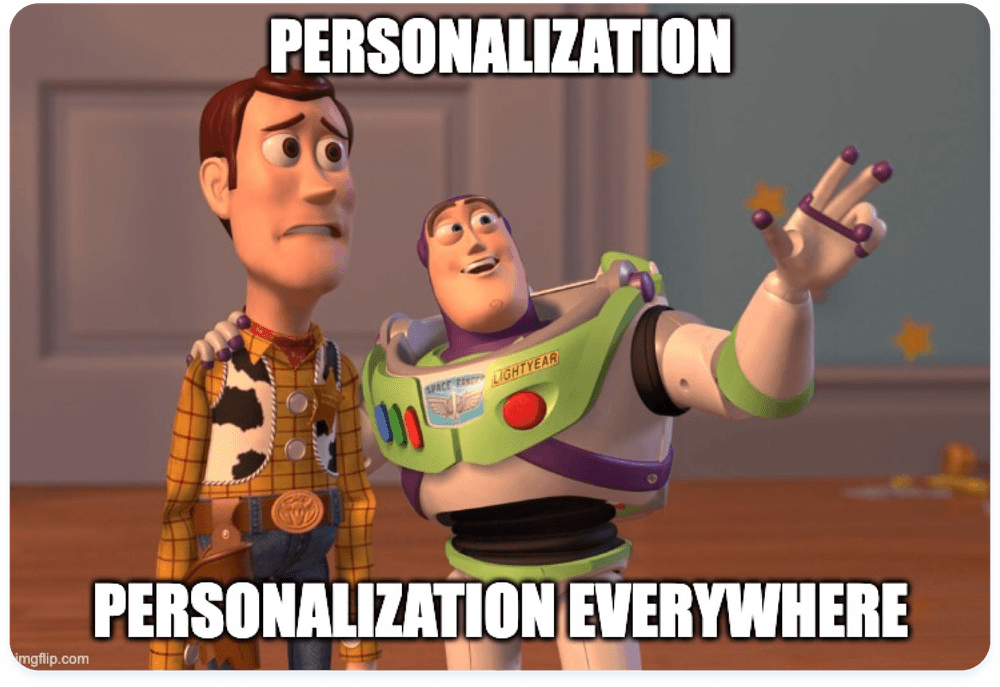
Personalizing the learning experience is on the radar, and for good reason. For example, with profound analytics, EdTech companies understand exactly which parts of the course to improve as they see when the students pause or skip videos.
Teachers can shift some of the workload to the co-pilot. Given how diverse students’ abilities and goals can be, AI helps teachers care more about each student.
It can personalize courses, too. AI can provide additional challenges for top students, or explain topics in more detail to the low performers and learners with special needs.
AI for educational administrative tasks
Let’s admit that: computers handle statistics much better than humans.
In schools and EdTech platforms, AI can uncover patterns and automate routine tasks, reducing administrative burden and freeing educators to focus on teaching. Common areas where AI adds value include:
- Scheduling: Optimizes class timetables and room assignments to avoid conflicts.
- Staff allocation: Assigns teachers and assistants based on workload and expertise.
- Enrollment management: Streamlines student registration, class sizes, and waitlists.
- Assessment preparation: Automates grading, analysis, and identification of learning gaps.
- Content adaptation: Converts learning materials into accessible formats like Text-to-Speech or personalized modules.
By automating these routine tasks, AI not only saves time but also ensures consistency and accuracy in administrative work. This allows educators to focus on personalized student support, curriculum planning, and engagement rather than repetitive operational tasks.
For example, a US-based LMS provider wanted to make learning content more accessible and engaging. By evaluating and integrating an AI-powered Text-to-Speech solution, the Aristek team not only enhanced learner experience but also streamlined content delivery workflows.
AI handled the complex task of converting large volumes of specialized educational content into natural-sounding audio, reducing manual preparation time for instructors and operational overhead for the platform.
Applications include:
- Scheduling and resource allocation made easier by AI insights
- Automated content delivery (e.g., TTS conversion) to save staff time
- Enhanced assessments and learner tracking through AI-powered analytics
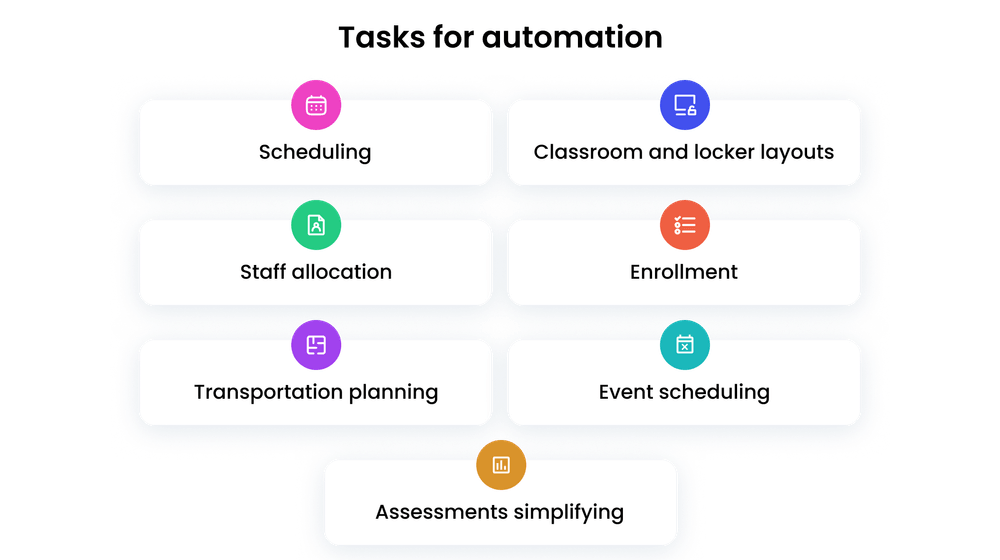
AI for teacher support and professional development
Can AI be used in education to enhance teaching? Yes, AI can help teachers save time, track student progress, and improve learning outcomes.
By using AI-driven technologies, teachers receive significant support in their everyday tasks. These technologies expand the teachers’ “toolbox” by offering new possibilities for designing and adapting lessons.

When asked if they have used AI to speed up routine tasks, 60% of Forbes Advisor’s respondents said yes. For teachers, this is a significant indicator – and a time-saver, no less.
The use of AI in schools is sometimes hotly debated in the public debate. Decision-makers such as school management and school authorities may struggle to weigh the advantages and disadvantages.
At Aristek, we handle each solution on a case-by-case basis, tailoring it to your needs.
AI in education: advantages and disadvantages
As with any other innovative technology, AI can bring both benefits and challenges. One key question often asked is: can AI be used for education effectively? While AI can personalize learning, automate assessments, and provide real-time feedback, it also raises concerns around data privacy, disinformation, and overreliance on technology.
Pros
- Greater learning success
AI can provide valuable insights into students’ learning progress. This helps teachers respond more specifically to individual needs and design individually tailored learning opportunities.
- Considerable time savings
AI can take over certain recurring tasks or, for example, help generate ideas for new teaching concepts. This saves teachers time for other responsibilities.
- Combating teacher shortages
If teachers can make their task management more efficient by using AI tools, school management can also use their limited human resources more effectively and thus alleviate the teacher shortage to some extent.
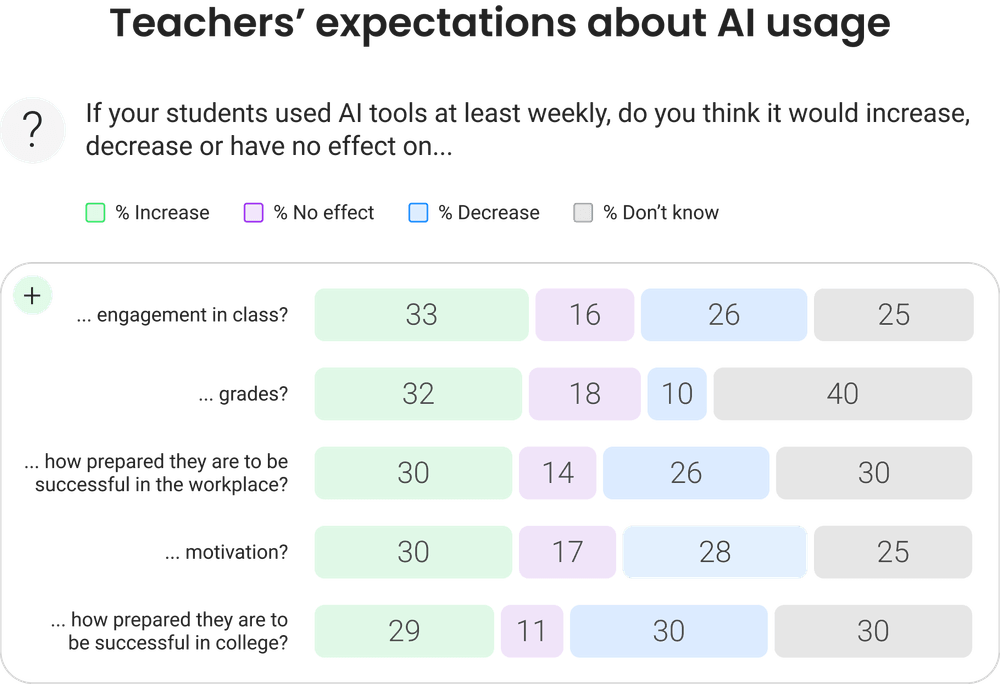
Cons
- Unequal learning conditions
Students may be tempted to use AI for homework, presentations, or papers. But overreliance reduces the learning effect because they engage less with core skills. It can also create unequal learning conditions when some students have access to more advanced tools or paid AI features than others. In addition, the school may convey critical values regarding simplifying work and managing tasks.
- False and disinformation
AI is not perfect. It can contain false information that it uses for its results, but does not label it as such. There is a risk that students will take the information they get from AI tools as true and not question it.
- Initial additional effort
Teachers need appropriate training on AI integration in education. One teacher from central Alberta said, “AI is definitely helpful for my workflow, but right now it feels like one more thing piled onto an already impossible workload. The policy says, ‘embrace innovation,’ but where’s the guidance and support?” As follows, the necessary technical equipment must first be procured. The school management has to invest additional time and money in this.
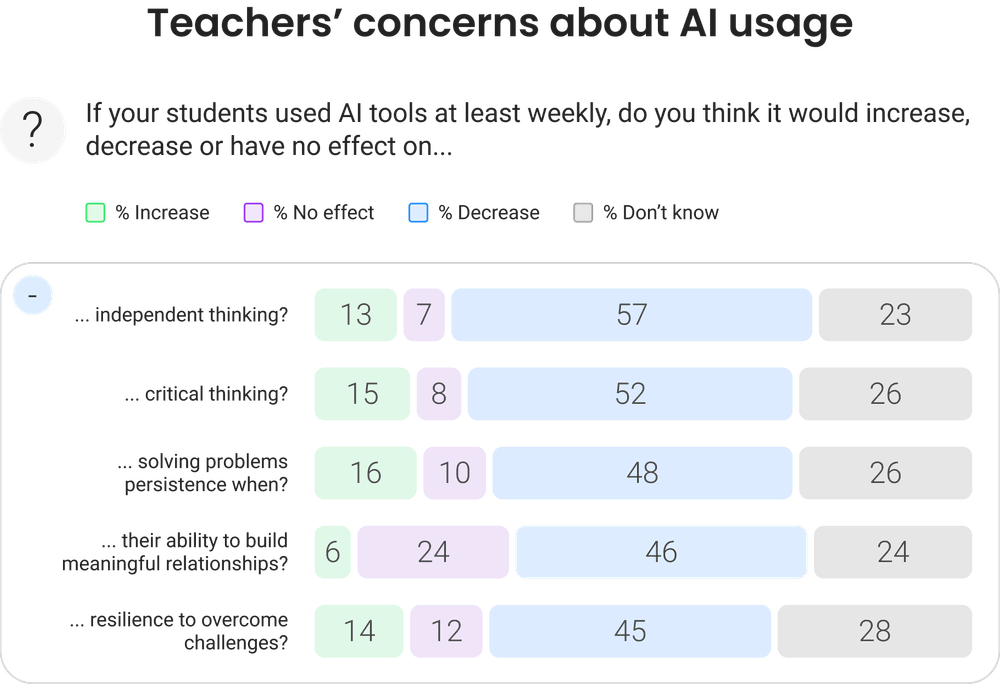
Striking a win-win balance between the technology’s advantages and disadvantages is possible. The better warned, the better armed: that’s why we have researched the advantages and disadvantages in a dedicated article. There, you can also learn the precautions you should take when adopting new technologies.
AI in educational assessment
With the need for distance learning quickly becoming a necessity, the use of AI in K-12 and higher education has evolved. Paper and pencil tests are no longer the only option; adaptive tests created with multitool content generators can provide an engaging, accessible assessment that is available to students whenever they need it.
Students can take tests tailored to their ability level, while teachers gain a deeper understanding of student progress that feeds into classroom learning.

What is adaptive learning?
Adaptive learning is an educational method that tailors the learning process to each learner’s needs, abilities, and learning styles. Since each person acquires knowledge at their own pace, this approach contributes significantly to learning success.

While the learners, their learning environments, learning speeds, and learning times were previously unknown and not considered, AI-driven adaptation enables the e-learning offering to follow the current learning situation. In addition to demographic and other static data on the learning environment, both verbal and non-verbal feedback from the learners is considered.
How does adaptive learning work? AI algorithms track various indicators which are either automatically or manually interpreted. As a result, content, methods, structures and the delivery of e-learning content can be adapted to the needs of each learner. These indicators include:
- Interactions
- Answering questions
- Digital absence (close, focus)
- Environment (device, location, noise, etc.)
- Peers/learning groups
Adaptive learning offers the possibility of individual adaptation of learning paths, efficiency/time savings depending on previous knowledge, and individual feedback. Thus, it has the potential to increase learning motivation. Learn all the adaptive mechanisms peculiarities in a dedicated material.
However, content adaptation must also take into account the shrinking perception time of information. Research shows that learners’ attention span has decreased dramatically: from 2,5 minutes in 2004 to 47 seconds on average today.
The fast-growing share of video content is growing rapidly, and as a result, content creators cannot always make succinct summaries. Therefore, not all content can be created by relevant regulations.
How to incorporate AI into the educational process
In our experience, the dos and don’ts of implementing AI depend on a case-by-case basis. However, in any case, adhering to a predefined strategy is key to successful technology adoption. A basic strategy’s option contains six steps.
- Conducting an AI potential analysis
Identification of fields of action in the various departments of an educational institution - Identification of specific use cases
Development of ideas and suggestions for particular workflows and processes - Use case scenarios
Calculating the approximate economic benefit of investing in an AI solution - Vision and goals
Defining a future vision for a company or a specific area - Building and empowering departments
Planning change management and transfer of the necessary know-how - Implementation/removal of barriers
Introduction of the AI solution in the organization
Ultimately, if you want to understand which AI tools are used in education, consider platforms that generate quizzes, offer predictive analytics, and provide smart feedback.
Is AI in education ethical?
One of the most prominent ethical concerns related to the future of AI in education concerns learner data protection and privacy. AI systems often collect extensive data about participants’ learning behavior, performance, and interests. The most rumored concerns include:
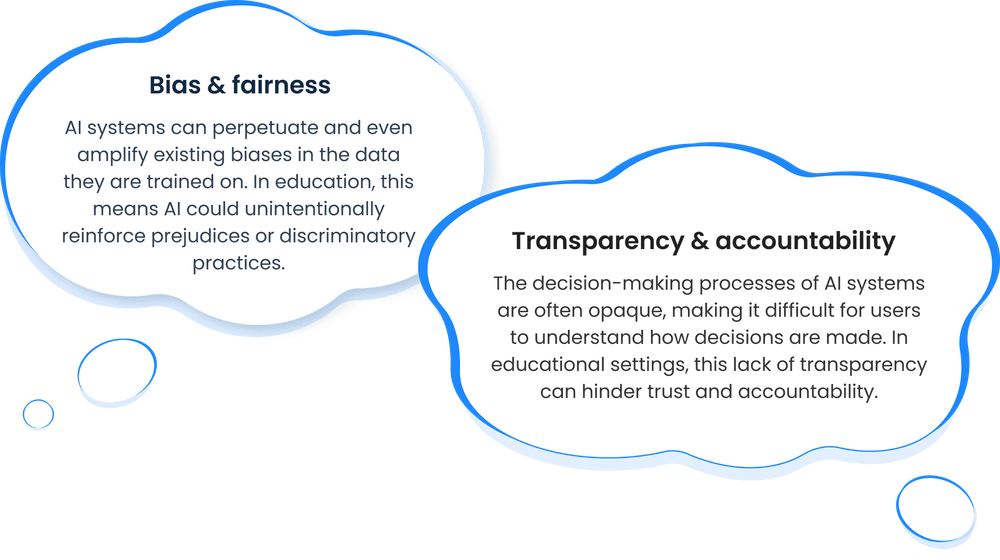
Check out our POV on this sensitive topic and what ethical standards software developers should adhere to.
AI and data privacy in education
AI systems in education rely on large amounts of student data, which naturally raises concerns about privacy and security. Safeguarding this data to prevent misuse or breaches is essential.

At the same time, as AI tools become more widespread in schools, several misconceptions about their reliability and compliance have emerged. Some of the most common myths circulating in the education field include:
- Large learning models (LLMs) constantly hallucinate and give incorrect information.
- Using LLMs exposes sensitive data and violates security or privacy standards.
- Using ChatGPT or Gemini is against GDPR and other data protection laws.
- LLMs can be easily manipulated with malicious prompts that reveal confidential information.
- Secure LLM implementation and support are too complex and expensive for most organizations.
Our in-house AI R&D professionals have successfully debunked all five of these myths. Read this article to see how these beliefs are largely unfounded.
It’s important to note that AI tools that do not require registration (for example, asking only for a name or email) and are used by students on school premises do not fall under data protection regulations, as no personal data is processed.
However, for AI tools that require student accounts and handle personal data, schools are responsible for ensuring compliance with applicable data protection regulations, even if students create the accounts themselves.
Learn all about AI safety
Stay ahead of threats and protect your AI systems. Download our comprehensive whitepaper to explore AI security challenges, vulnerabilities, practical safeguards, and ethical guidelines – everything you need to keep your AI resilient and trustworthy.
When selecting AI tools that require registration, the school should check the following:

We go into more detail about the legislation that regulates the use of AI in this article.
How to evaluate the AI readiness of your business
Since technology adoption impacts the entire organization, three key aspects must be considered: strategic, technological, and organizational.
- Strategic focuses on defining clear goals to solve business challenges, aligning key stakeholders on objectives, and ensuring measurable ROI to justify AI implementation.
- Technological includes ensuring data readiness and quality, planning AI functionalities that align with business needs, and implementing robust security measures to mitigate risks.
- Organizational emphasizes fostering a culture of change to build trust in AI, educating teams on how to work with AI tools, and seamlessly integrating AI into existing workflows and processes.
So, how to ensure a successful digital transformation considering all the abovementioned aspects? In a dedicated material, Aristek’s CTO Aleksei Turchak shares expert pieces of advice and warns about potential pitfalls – check it out to stay on top of things.
Conclusion
In response to the increasing role of AI in education, organizations like the U.S. Department of Education and UNESCO advocate for a transparent, human-centered approach that prioritizes educators’ roles and promotes equity.
AI companies are responding to these concerns, continuously improving their services specifically for higher education with enhanced privacy and tailored educational tools.
Despite the challenges AI introduces, most teachers surveyed maintain a positive outlook on its potential. Through personalized learning paths, efficient knowledge transfer, and intelligent feedback, the possibilities of AI in education are limitless.
However, the potential of AI must be harnessed without ignoring the ethical issues and data protection concerns. Aristek’s experts, backed by our extensive experience in technology implementation, are here to assist you – reach out to us for a consultation.
Set up the use of AI in a snap
Our experts can help you bridge the gap between technology and users by providing hands-on guidance and advice.
